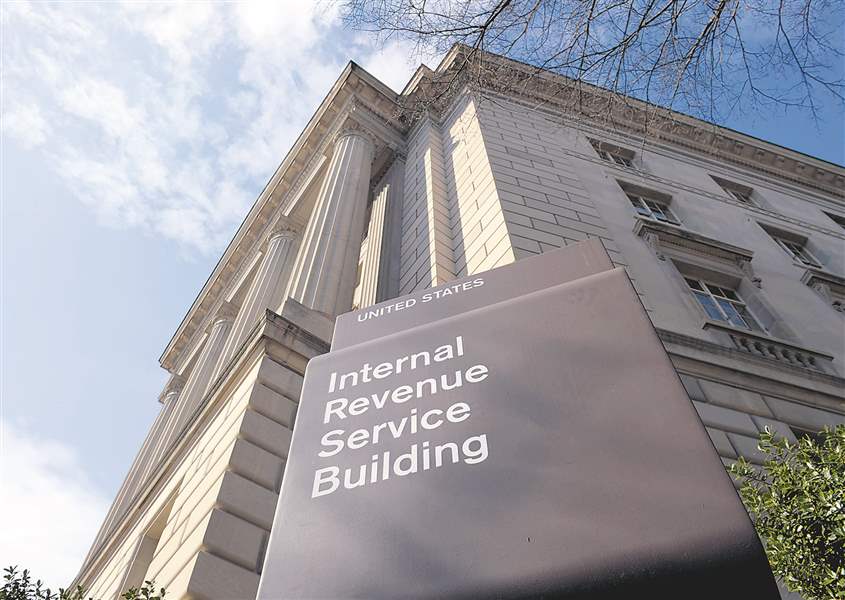
Changes in tax code affect mostly upper-income filers
Area preparers say for rest of clients, laws remain similar
2/23/2014
Tax preparers say not many changes that were made to the tax code in 2013 will apply to filers in the middle-to-lower income tax brackets.
ASSOCIATED PRESS

Lynn Bishop of Toledo, a tax specialist with H & R Block in Holland, helps a client prepare her taxes.
For most Americans, filing taxes this year won’t be much different than last year. There were not many changes enacted in 2013 that will require much attention for those in the middle-income to low-income tax brackets.
But for higher wage earners, it is a different story.
“If you’re affluent, you’re going to pay more tax. This is the beginning of redistribution,” said Chuck Mira, a partner with the Toledo firm of Mira & Kolena CPAs.
“Most of the new taxes that will be applied will be applied to higher-income tax bearers,” agreed Chuck Kissling, a certified public accountant and co-owner of Tucker, Kissling & Associates in Oregon.
“We had those discussions with our clients in November and December as we were doing year-end tax preparations,” Mr. Kissling said. “For those it’s going to impact, I believe they’re mostly aware of those taxes and have made plans to cover their liability.”
RELATED ARTICLES:
- Where to find assistance for preparing, filing taxes
- Here's who should file their income tax, who you can call for help
For this tax filing season some high-wage earners likely will face three issues.
First is an Additional Medicare Tax of 0.9 percent that applies to Medicare wages, railroad retirement compensation, and self-employment income.
Another big issue is a new Net Investment Income Tax — NIIT — that subjects some taxpayers to a 3.8 percent tax on the lesser of net investment income or the excess of one’s modified adjusted gross income over $125,000 for marrieds filing separately, $250,000 for marrieds filing jointly, and $200,000 for any other filing status.
Lastly, high earners will see that the previous top tax bracket of 35 percent has been replaced by a 39.6 percent bracket. The new top bracket will apply to taxable income over $400,000 for single filers, $450,000 for marrieds filing jointly, $225,000 for marrieds filing separately, and $425,000 for heads of households.
“It is a significant amount of money, but people should keep in mind that with the tax rates it actually means that your first $9,000 [to $36,000] is taxed at 15 percent, the next $36,000 to $87,000 is taxed at 25 percent, and so on,” said Internal Revenue Service spokesman Jennifer Jenkins. “It’s not the entire amount [that] is taxed at 39.6 percent.”
Rex Decker, a tax partner at the firm of Sobb Roberts Inc. in Sylvania Township, said the new top bracket has affected a lot of his professional clients — attorneys, physicians, and others.
“The only positive thing about it is if the rate goes up some of the people who may have been subject to the [Alternative Minimum Tax] have found they’ve now grown past the AMT and don’t have to pay it this year,” Mr. Decker said.

Tax preparers say not many changes that were made to the tax code in 2013 will apply to filers in the middle-to-lower income tax brackets.
The 0.9 Additional Medicare Tax, which went into effect on Jan. 1, 2013, is a direct result of the Patient Protection and Affordable Care Act, commonly known as Obamacare.
All wage earners pay a 1.45 percent Medicare tax, but the new 0.9 percent tax is aimed at high wage earners and specifically created, along with the Net Investment Income Tax, to help fund the Affordable Care Act.
The 0.9 percent tax applies to wages, compensation, or other income over $125,000 for marrieds filing separately, $250,000 for marrieds filing jointly, and $200,000 for singles. In most cases, an employer will withhold the tax from wages in excess of $200,000.
The 3.8 percent Net Investment Income Tax is another new tax that could hit high-wage earners in the pocketbook.
It also went into effect on Jan. 1 of last year and is aimed at taxing investment income of high wage earners. Forbes magazine estimates this tax probably will apply to about 6 percent of the population.
But the new tax has some tricky language that could make applying it “iffy” when the IRS begins looking at a tax return, experts have said.
First, it only applies to the “smaller” of net investment income, or the excess of a filer’s modified adjusted gross income. So if, for example, an individual tax filer had investment income of $100,000, and a modified adjusted gross income of $250,000, they would only have to pay the 3.8 percent tax on $50,000.
The “iffy” part is what counts as investment income.
The IRS’s definition of investment income was finalized only at the end of November, and as opposed to previous ideas about investment income — dividends, interest, etc. — the government decided interest income includes interest, dividends, annuities, royalties, rents, substitute interest payments and substitute dividend payments, gross income from either a passive activity or a trade or the business of trading in financial instruments or commodities, and gains attributable to the disposition of property.
“I think people get the point of the 0.9 percent, but I think the 3.8 percent is surprising a lot of people,” Mr. Decker said. “The 3.8 percent is a lot more complicated, and it hits a lot more income streams.”
Before the Net Investment Income Tax, taxpayers never had to think about a lot of their investments, he said. “Now you have to think how much did you actively participate in a small business. If you’re a passive investor, then the investment in your small business becomes subject to the 3.8 percent. If you’re not passive, you’re not subject to the tax, but they have all these rules and test to determine passive activity.
“You have to have 500 hours a year in a business for it to be considered active investment. For somebody with 10 small businesses, it’s hard to meet that,” Mr. Decker said.
“We’re having to do a lot of analyses to figure this thing out. We are asking people, ‘How many days did you work, and did you keep a diary of your activity?’ Most people don’t,” he said.
The personal exemption this year has increased by $100 to $3,900. Most tax filers can take a personal exemption for themselves, or if they are married, for their spouse as well. However, under new rules enacted last year the personal exemption starts getting reduced if an adjusted gross income is more than $150,000 for marrieds filing separately, $250,000 for singles, and $275,000 for heads of households, and $300,000 for marrieds filing jointly.
The standard mileage rate in 2013 for tax-filing purposes this year is 56.5 cents a mile for business use of a vehicle, and 24 cents for medical use for a vehicle.
In general, there just weren’t a lot of changes to the tax laws in 2013 that should impact most filers between now and April 15.
It wasn’t a change in the law, but the IRS enacted a new policy that could affect some tax filers.
Starting with this season — for the 2013 tax year — the IRS is requiring same-sex couples who were legally married in a state or foreign country that recognizes same-sex marriages to file as a married couple, either married filing jointly or married filing separately.
That could add some confusion in states that do not recognize same-sex marriage.
Ohio is one of those states, and as a result, when same-sex married couples in Ohio file their state returns, they will be required to file as single individuals.
However, if they were legally married elsewhere, when they file their federal returns they must use the married filing jointly or married filing separately status.
Ms. Jenkins said the change in the IRS’ filing policy occurred in August after key sections of the Defense of Marriage Act were struck down in June by the U.S. Supreme Court.
“That change stated that as of [Aug. 29] we at the federal level will consider all marriages legal at the federal level for tax purposes. We also did say that the same-sex couples must have the marriage performed in a state where such marriages are legal,” she said.
The change in policy also allows same-sex couples in a legally recognized marriage the last three years to file amended returns for the last three years that recognize their married status. Depending on their economic status, filing as a married couple could net some same-sex couples tax advantages for those three years and possibly a bigger tax refund.
“Somebody would have to crunch the numbers for their particular situation, but for any taxpayer it’s always worth it to take a look back and see if there’s some tax breaks you might have missed,” Ms. Jenkins said.
Contact Jon Chavez at: jchavez@theblade.com or 419-724-6128.